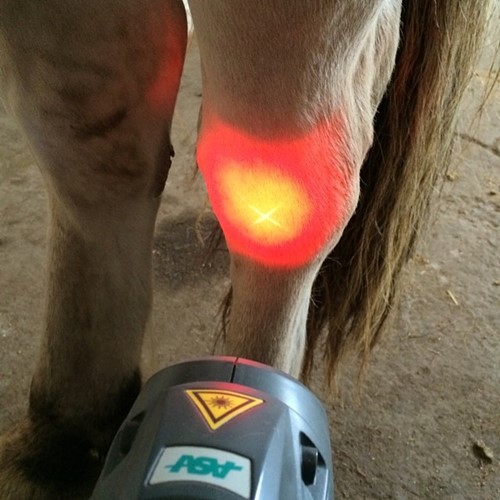Equine Therapy: How It Helps Build Confidence and Emotional Toughness
Equine Therapy: How It Helps Build Confidence and Emotional Toughness
Blog Article
Exactly How Laser Therapy in Equine Treatment Is Revolutionizing Vet Treatment for Equines
Laser therapy has actually arised as a transformative technique in equine vet care, supplying a non-invasive option that expedites recovery and improves total wellness. The mobility and convenience of laser treatment devices better highlight their growing necessity amongst vets.

Comprehending Laser Therapy
Understanding laser therapy is crucial for appreciating its function in equine therapy. Laser therapy, additionally referred to as photobiomodulation, involves the application of details wavelengths of light to tissues, which can result in numerous organic effects. This healing modality uses the power of light power to penetrate the skin and underlying cells, boosting mobile processes and improving tissue repair.
The technology behind laser therapy is based in the concept of photochemistry, where photons are taken in by chromophores within cells, bring about enhanced ATP production and modulation of reactive oxygen species. This, subsequently, promotes cellular expansion, lowers inflammation, and accelerates recovery. Veterinary professionals utilize different sorts of lasers, including low-level lasers (LLLT) and high-power Course IV lasers, relying on the certain therapeutic objectives and the nature of the equine problem being treated.
Different laser wavelengths and power setups are thoroughly chosen to target numerous tissue depths and attain preferred professional end results. Safety procedures are critical, as inappropriate use can bring about thermal damage or suboptimal restorative results. Hence, a detailed understanding of laser therapy's devices and applications is crucial for its effective implementation in equine veterinary technique.
Advantages for Equine Wellness
The myriad benefits of laser treatment for equine wellness include improved healing, discomfort reduction, and enhanced wheelchair. This innovative therapy method leverages particular wavelengths of light to permeate cells, stimulating cellular feature and promoting fast tissue repair. The non-invasive nature of laser therapy makes sure minimal stress and anxiety and pain for the equine, promoting a smoother recovery process.

Better wheelchair is an additional vital benefit, especially for efficiency and working steeds. By reducing inflammation and discomfort, and enhancing tissue repair, laser therapy assists in bring back joint feature and muscle versatility. The advancing result of these advantages is not just a quicker go back to regular activity yet also a total enhancement in the horse's lifestyle. Hence, laser treatment stands as a transformative device in modern equine vet treatment.
Typical Conditions Dealt With
Laser treatment has arised as a versatile treatment option for a variety of usual equine conditions. Among these, musculoskeletal injuries are particularly amenable to laser therapy. Soft cells injuries, such as tendonitis and ligament pressures, advantage from the anti-inflammatory and analgesic impacts of laser treatments, which speed up site link recovery and minimize discomfort. Additionally, laser treatment is effective for conditions like osteoarthritis, where it assists reduce joint swelling and advertise tissue repair work.
Wound administration is an additional area where laser treatment has actually shown substantial assurance. Chronic injuries or slow-healing abscess can be particularly challenging in horses, however laser therapy boosts mobile regrowth and improves blood circulation, hence accelerating the recovery procedure. Additionally, laser treatments have been effectively used in handling unguis conditions such as laminitis and abscesses, easing pain and advertising faster recovery.
Equine athletes often deal with performance-related problems like muscle mass discomfort and tension cracks. Laser therapy aids in lowering muscle fatigue and speeds up the healing of micro-injuries, therefore guaranteeing that horses return to peak performance quicker. By attending to these varied problems, laser treatment is transforming the landscape of veterinary treatment, providing a non-invasive, effective alternative to conventional treatments.
Innovation Behind Laser Therapy

Laser gadgets utilized in vet medication frequently Visit This Link utilize low-level laser therapy (LLLT) or chilly laser treatment. Unlike high-powered surgical lasers, these devices operate at lower power degrees, maximizing therapeutic advantages while minimizing thermal damage. The power from the laser light boosts adenosine triphosphate (ATP) production, improves mobile metabolism, and increases cells repair processes.
Modern laser treatment devices for equine therapy is created with adjustable Visit Website setups to provide to the specific requirements of different tissues and problems. Additionally, advancements in laser technology have actually led to the growth of portable, handheld devices, making it simpler for veterinarians to supply treatment in a selection of setups, from centers to stables.
Success Stories and Study
Showcasing the tangible benefits of laser therapy, many success tales and study illuminate its transformative effect on equine wellness. One such instance involves a thoroughbred racehorse suffering from chronic tendonitis. Standard therapies produced very little renovation, but after incorporating laser therapy right into the regimen, the steed displayed substantial reductions in inflammation and pain within weeks, ultimately returning to affordable racing.
Another compelling instance includes a dressage equine detected with extreme neck and back pain, limiting its performance. A veterinary team employed low-level laser treatment (LLLT) to target the inflamed locations, leading to significant improvement in versatility and a notable reduction in pain. Over several sessions, the equine restored its peak form, showcasing the effectiveness of laser therapy in dealing with bone and joint concerns.
Furthermore, a study performed at a leading equine facility analyzed 50 equines with numerous soft tissue injuries treated with laser treatment. The outcomes were striking: 85% of the steeds showed accelerated recovery times and boosted flexibility. These cases underscore the convenience and effectiveness of laser therapy in equine medicine, supplying a non-invasive, scientifically-backed technique to boosting recovery and performance in steeds.
Verdict
Laser therapy is transforming equine veterinary care by providing a non-invasive treatment that speeds up recovery, reduces swelling, and alleviates pain. With its efficiency in dealing with a variety of conditions, from musculoskeletal injuries to chronic conditions like osteoarthritis, this technology significantly enhances equine health and movement. The portability and versatility of laser therapy better highlight its transformative influence on vet methods, solidifying its role as an important tool in contemporary equine health care.
Report this page